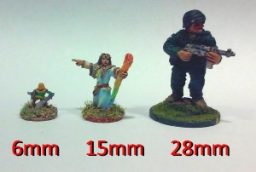Building a Better Miniature Wargame: The Grand Strategy
Wednesday , 4, January 2017 Tabletop Games, Wargames Leave a comment
Strategy is as important in planning a wargame project as it is in winning a wargame itself.
Miniature wargamers are both blessed and cursed to live in a golden age of the hobby. Thanks to advances in material science and manufacturing, combined with the reduced cost of shipping and ease of cross-border payments, the cost and selection of figures available to wargames have never been better. The revolution in self-publishing has led to an explosion of rulesets that cover every setting, period, conflict, and scale. In short, there is literally no conflict for which you cannot find at least one line of figures and one set of rules. All these options lead to two dead-ends for actual gaming, the dreaded analysis-paralysis and gamer attention deficit disorder. Every grognard has at least one perpetually unfinished game stuffed in a box somewhere, and no game is ever truly complete. It may be playable, but there’s always one more figure, one more unit, or one more terrain piece. Miniature wargames are a hobby for collectors, after all.
If you’re looking to miniature wargaming as a way to meet people in your area, the best way to pick a game is to play what others play. As hobbies go, it’s as welcoming as any other, and if you play what the locals play, you’ll have an easier time meeting people. Your friendly local storefront, if they have any business sense at all, will likely have a few game nights where you can sit in, meet the regulars, and find out what sorts of games get the most table time in the area. The benefits of this approach are obvious, you only need to build one faction of the conflict because your opponent will already have a matching force, and you can most likely use the terrain at the store or your opponent until you build up enough terrain to host your own game. The downside is that you’ll be stuck playing what everyone else plays. This means larger mass-produced games heavy on the IP and salesmanship, and depending on your area, you may wind up playing in competitive style play which focusses on rules-lawyering and production lines that incorporate ‘power creep’ as a selling point. If you aren’t interested in that sort of costly arms race, then you’re much better off playing in more casual, niche games.
Whichever route you take, the goal of this series is to help you stay focused on the end goal of producing a playable game that is not just fun to play, but that is also visually appealing. Individual posts will lay out the tactics for each step of the process, but you can’t implement your tactics if you lack a grand strategy. Even though you know there is no finish line, you still need to pick a direction and set some goals, or at least some operational parameters.
At this point you really only need to make two choices – what scale and what setting.
Scale: Whatever game you choose to build, you’re going to wind up with somewhere between three and twenty discrete operational units. Each unit could be one man (commonly referred to as “skirmish gaming”) or a full legion of forces (commonly referred to as “mass battle”). Bear in mind that different rulesets will bridge the gap between the two extremes. For example, it’s possible to find rulesets for battles from every size, from man-to-man, to squad level, platoon, and so on up to grand strategic.
Don’t worry about complexity at this point. For miniature wargaming you’re going to wind up with up to twenty individual maneuver units. At the squad level each unit might be one man, at the platoon level they might by squads or fire teams, and at the mass battle level each unit might be a full legion or battalion. The rules always scale with the maneuver unit. You won’t be giving orders to individual soldiers in a mass battle game – instead, your decision making abilities and resources will scale along with the size of the unit.

There are a dozen other scales, and a lot of variance even within this limited subset. You may want to stick with one manufacturer per project.
The term scale also applies to figure size. The three most popular figure scales are 6mm, 15mm, and 28mm. Generally speaking, figures are measured from floor to eye level, so the 6mm figures are the smallest and are used in large numbers to represent massed columns and blocks of troops. The 29mm figures stand tall, and show enough detail that each has a personality all its own. Although they are sometimes used in massed blocks of troops, the high cost in both money and painting time can be prohibitive for use in mass blocks for all but the most hard-core collectors and wargamers. The mid-sized figures offer a compromise on both cost and detail. They are large enough to be used individually, but cheap enough and paint up fast enough to be used in blocks for mass combat games.
Setting: The sky is not the limit here. There is no limit. You can choose any historical period, any realm of fantasy, any far off sci-fi horizon, and build a game to suit. For now, the important thing is to choose a theme that you know will hold your attention over the long haul. Your first miniature wargame is not the time to flirt with something that you’re going to lose interest in as fast as your New Year’s Resolution.
Those two questions will direct the next steps in the process, as they will narrow down your choices for rulesets, which in turn will help guide your selection of figures. As is often the case, the process can be iterative. If you can’t find a decent set of rules for your chosen scale/setting, you might bump up a level in operational scale to match your setting, for example. Or maybe you found a highly recommended set of rules, but it’s for a different scale, so you change the scale now. Maybe you find a figure line that calls to you, and just want to paint and use those figures, so you look for a ruleset to use with them.
Either way, we’re going to embrace the fallacy of sunk costs and use the early purchases to stay motivated to complete this project. Sunk costs are terribly motivators in financial investing, but they are great for wargamers. You might be tempted to buy that gorgeous new squad of terminator looking robots, but if you’re wrist deep in an American Civil War game, you’ll have a reason to skip that purchase and buy the more genre appropriate clapboard church and farm house instead.
The second important part of our strategy to motivate ourselves to complete a game with a reasonable cost and amount of time is focus. This is not the time to start building a re-fight of Culloden Moor on a one-to-one basis. We want fast and cheap here so that we can get playing as soon as possible.
The massive number of figure lines, rulesets, settings, and even figure scales prohibits concrete and specific guidance at this stage of the project. You have to choose a project that will keep you motivated. If you need specific advice on rulesets or figure scales, there’s a comment section right below this post. Fire away, and the regulars at Castalia House can point you in specific directions. That said, let’s put the discussion so far into practice, and thereby introduce you to the example that will be used for the rest of 2017.
Most of my miniature gaming has been towards the fantasy and science fiction side of things, and I’m looking for something a little more historical. In addition to that, I’ve been on a pulp fiction kick, and considering looking back even further. Reading The Three Musketeers has been on my bucket list for a while, and if I start to build a game set in the world of Dumas, that will motivate me even more. The whirl of flashing blades and sweeping capes suggests a decent skirmish game. It just so happens that I’ve already reviewed a miniature wargame for the Castalia House blog called En Garde! To this day, I still haven’t played a game of that, so it makes for a natural choice.
The big question is, what scale figure to use? The 6mm figures are way too fiddly for the sorts of bar-room brawls and street duels that I anticipate playing. As much as I love the detail of the larger figures, given my time constraints, given my limitations with time and space, it’s got to be 15mm or nothing. The price difference alone ($3-5 per figure for 28mm versus $1 per figure for 15mm) is enough to convince me.
If you want to play along at home, and you prefer the larger figures, you can find great musketeers at Black Hat, Redoubt, Old Glory, or Brigade Games (courtesy of North Star Figures). If you prefer the cheaper and less detailed 15mm – what I’ll be using – then Blue Moon (by way of Old Glory) has you covered. For roughly $35 you can get the Four Musketeers, fifteen Cardinal’s guards, and a handful of generic swashbuckling highwaymen. Or swap out the Cardinal himself, Rochefort, and three ladies for the highwaymen if you prefer to hue closer to the canon literature.
Next time out we’ll look at how to prepare your figures for play including a detailed look at achieving a decent table-ready standard of painting that will give you great results in a reasonable time frame.
Please give us your valuable comment